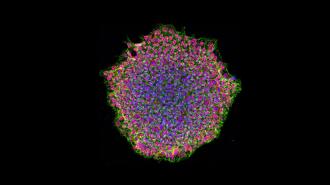A new treatment for epilepsy slashed the frequency of seizures by 95% in its first two patients. If it performs as well in larger trials, it could be a better, safer alternative to brain surgery for people with drug-resistant epilepsy.
Epilepsy 101: The brain relies on tiny, steady impulses of electricity to function, but sometimes this controlled brain activity is overwhelmed by a sudden, excessive burst. That’s called a seizure, and it can cause uncontrolled movements, unconsciousness, and other severe symptoms.
There are many potential triggers for seizures — a serious head injury can cause one, for example — but people with epilepsy experience recurrent seizures. They also tend to be at higher risk of mood disorders, cognitive impairments, and other health issues.
Tumors, strokes, genetic mutations, or an imbalance in neurotransmitters (the chemicals that tell neurons to fire or not) are all potential causes of epilepsy, but some people develop the condition for no discernible reason.
The patient’s seizure frequency dropped by more than 95% — and the final five months of the year were seizure-free.
The challenge: Of the estimated 50 million people with epilepsy, about two-thirds are able to control their seizures with medication. The remaining one-third have drug-resistant epilepsy (DRE), meaning they weren’t able to get their seizures under control after trying at least two different meds.
A person with DRE may opt to undergo surgery to remove the part of their brain where the seizure is coming from, but those procedures are risky, often unsuccessful, and can lead to new problems with cognition and memory.
What’s new? California-based biotech company Neurona Therapeutics has now presented preliminary results from a trial of its in-development treatment for epilepsy, NRTX-1001. The treatment, made with stem cells, was injected directly into the brains of two people with DRE, at the site of their seizures.
The injections appeared to allow patients’ memories to improve.
In the six months prior to the trial, the first patient was experiencing an average of 32 seizures a month. In the year after receiving the treatment for epilepsy, their seizure frequency dropped by more than 95% — and the final five months were seizure-free.
The second person was averaging 14 seizures per month, and they saw a more than 90% reduction in their seizure frequency in the seven months after treatment.
At the start of the trial, both people were suffering from impaired cognition. Based on neurocognitive testing before treatment and for six months after, the injections not only didn’t cause any further cognitive problems, but also appeared to allow patients’ memories to improve.
How it works: Neurona’s treatment for epilepsy is designed to prevent seizures by permanently restoring balance in a person’s neurotransmitters.
“The human interneurons are … designed to durably silence seizure activity in the epileptic region of the brain.”
Neurona Therapeutics
The treatment starts with human pluripotent stem cells, which are coaxed to develop into inhibitory “interneurons.” These brain cells act as bridges between other nerve cells in the brain, and the ones in NRTX-1001 secrete a neurotransmitter that inhibits electrical activity.
By injecting them into the site where seizures begin, these cells are designed to counterbalance and dampen these excessive bursts of electricity.
“Delivered as a one-time dose, the human interneurons are intended to integrate and innervate on-target, and designed to durably silence seizure activity in the epileptic region of the brain,” according to Neurona.
Looking ahead: Neurona presented the preliminary trial results at the Annual Meeting of the International Society for Stem Cell Research, but has yet to publish them, so the data still needs to undergo peer-review.
“It is gratifying to witness the first two patients achieving seizure-relief without additional cognitive impairment.”
Cory R. Nicholas
Additionally, while these results are promising, a treatment’s apparent effect on two people isn’t enough to determine whether it works. Neurona is still enrolling people in its trial, though, with the goal of including 10 people in this early phase to test the drug’s safety, tolerability, and efficacy.
If the injections continue to perform well, larger trials could follow, potentially giving people with DRE a safer, more effective way to control their seizures.
“Although our clinical investigation is ongoing in additional patients, it is gratifying to witness the first two patients achieving seizure-relief without additional cognitive impairment to date, which supports the therapeutic potential of NRTX-1001,” said Neurona CEO Cory R. Nicholas.
We’d love to hear from you! If you have a comment about this article or if you have a tip for a future Freethink story, please email us at [email protected].






